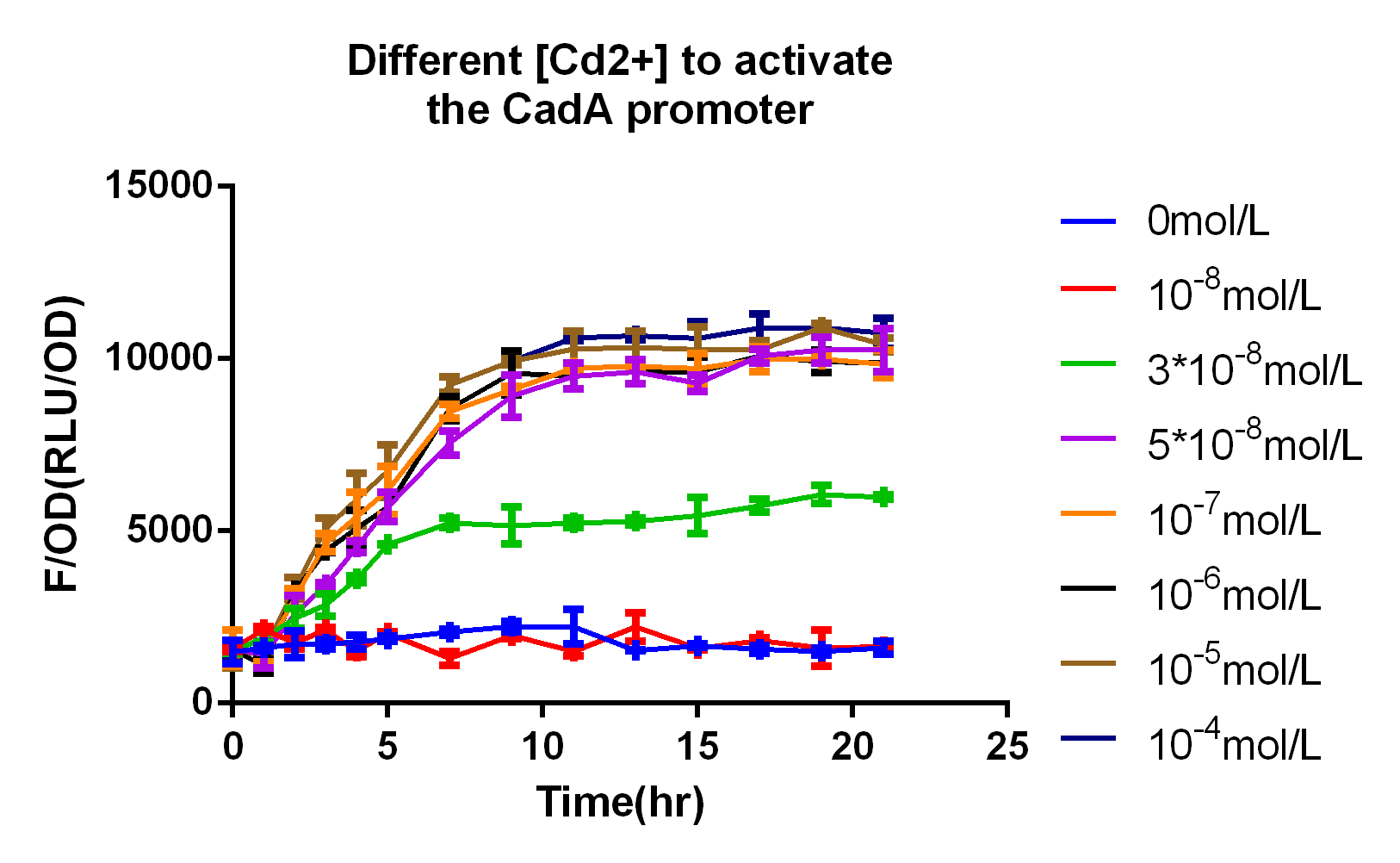Difference between revisions of "Part:BBa K1724000"
| Line 13: | Line 13: | ||
| − | [[Image:2015result 2.jpg|500px|thumb|center|Figure 2. Accumulation of RFP fluorescence in culture of engineering E.coli.The promoter CadA Strength test in the concentration of 10^-6 mol/L and 0mol/L cadmium chloride and 0mol/L. We construct Constructive promoter +MerR+termintor & PCadA+CsgA-EC(n)+RFP+tetR+termintor into E.coli | + | [[Image:2015result 2.jpg|500px|thumb|center|Figure 2. Accumulation of RFP fluorescence in culture of engineering E.coli.The promoter CadA Strength test in the concentration of 10^-6 mol/L and 0mol/L cadmium chloride and 0mol/L. We construct Constructive promoter +MerR+termintor & PCadA+CsgA-EC(n)+RFP+tetR+termintor into E.coli. The abscissa is the time after we add the cadmium chloride . The ordinate is RLU/OD. The curve indicates that the engineering E.coli can be activated and go into stabilization phase at 9 hours.]] |
== 2.Detection limit of promoter CadA == | == 2.Detection limit of promoter CadA == | ||
| Line 21: | Line 21: | ||
[[Image:2015result 3.JPG|500px|thumb|center|Figure 3. The visible test of detection limitation. The flag on the 50ml tube was the concentration of cadmium ion. As seen in the picture, 3*10^-9 and 1*10^-8 mol/L Cd2+ cadmium medium didn't change into red contrast of 3*10^-8 and 5*10^-8. The minimum motivating concentration is between 10^-8 and 3*10^-8 mol/L.]] | [[Image:2015result 3.JPG|500px|thumb|center|Figure 3. The visible test of detection limitation. The flag on the 50ml tube was the concentration of cadmium ion. As seen in the picture, 3*10^-9 and 1*10^-8 mol/L Cd2+ cadmium medium didn't change into red contrast of 3*10^-8 and 5*10^-8. The minimum motivating concentration is between 10^-8 and 3*10^-8 mol/L.]] | ||
| − | [[Image:2015result 4.png|500px|thumb|center|Figure 4. The actual data of activation limit of promoter CadA after inducing within | + | [[Image:2015result 4.png|500px|thumb|center|Figure 4. The actual data of activation limit of promoter CadA after inducing within 21 hours. Lower than 10^-8 mol/L, the cadmium cannot motivate the operon CadA/MerR, contrast of the higher concentration. Meanwhile, more than 10^-7 mol/L, the expression of RFP stays steady, the maximum is near 11000 RLU/OD. |
So we can come to a conclusion that the lowest concentration of cadmium to activate promoter CadA is between 10^-8 and 3*10^-8 mol/L.]] | So we can come to a conclusion that the lowest concentration of cadmium to activate promoter CadA is between 10^-8 and 3*10^-8 mol/L.]] | ||
Revision as of 17:12, 15 September 2015
Pcada
Introduction
CadA promoter is a cadmium-sensitive promoter. Its repressor is MerR. In high concentration of cadmium, the Cd2+ can rapidly bind with MerR and remove its inhibition of CadA promoter. The reverse is the opposition.
1.Promoter CadA quantification
In 2015 SCUT team, we expressed our three proteins by the downstream of promoter CadA. Promoter CadA is Cd-activated promoter with the presence of MerR. When enough Cadmium existed, the gene downstream can be express. We construct MerR/CadA operon and place the RFP behind the CadA promoter. As the detection limitation mentioned below, the lowest concentration of the cadmium ion is between 10^-8 and 3*10^-8. So we set up the gradient concentration(0, 3*10^-8,10^-7,10^-6,10^-5,10^-4) of the cadmium ion in order to get the pattern of our promoter.


2.Detection limit of promoter CadA
In order to test the detection limit of the promoter CadA, we first set up gradient concentration of Cadmium(10^-8,10^-7,10^-6,10^-5,10^-4mol/L)to estimate the probably range. As the result mentioned above, the promoter CadA can be activated over the concentration of 3*10^-8. So we set up the gradient of Cd2+ (3*10^-9, 10^-8, 3*10^-8, 5*10^-8) and obtain the detection limit of promoter CadA.


Sequence and Features
- 10COMPATIBLE WITH RFC[10]
- 12COMPATIBLE WITH RFC[12]
- 21COMPATIBLE WITH RFC[21]
- 23COMPATIBLE WITH RFC[23]
- 25COMPATIBLE WITH RFC[25]
- 1000COMPATIBLE WITH RFC[1000]
